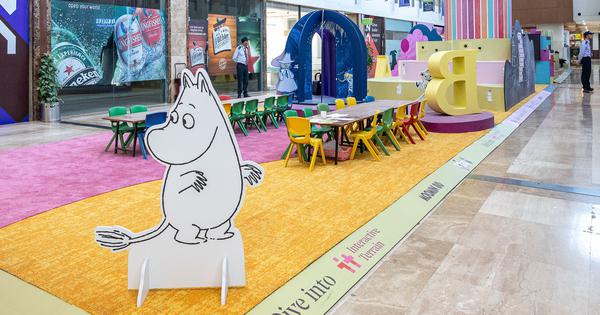
Towards the end of World War II, Finnish writer and illustrator Tove Jansson created a set of white, round characters with long snouts known as Moomins. They would go on to become a part of Finnish childhoods for generations: they featured in a cartoon strip, picture books, television series, films and three theme parks.
But, like the best children’s literature, there was more to the Moomins than meets the eye. Having witnessed the devastation wrought by Hilter’s Nazis and Mussolini’s Fascists, Jansson created the Moomins to “inoculate future generations against the conformity and power-worship that had made this human catastrophe possible”, notes an essay in the digital culture magazine Aeon.
It is one thing to know this background, but entirely another to witness the vision of a creator beyond the printed word and images.
Moomin 80 – The Door is Always Open at the Kiran Nadar Museum of Art in New Delhi is an interactive, immersive exhibition presented in collaboration with the Embassy of Finland. The exhibition celebrates the 80th anniversary of the Moomins.
Tove Jansson (1914-2001), Finnish author, novelist, painter, illustrator, comic strip author and creator the hugely successful ‘Moomins’ series #womensart pic.twitter.com/1Rx0rQJVLW
— #WOMENSART (@womensart1) August 26, 2018
The hippo-shaped Moomin family lives in a big blue house. In the series, the various characters who visit them are always welcome, despite their differences, “whoever they are, whenever they come”. Hence the exhibition is titled “the door is always open”. This openness is not just for characters but also for readers.
The exhibition features little structures with pastel artworks to walk through, recreating different parts of Moominvalley, a fictional place set within the sea, and the Lonely Mountains range where the Moomins live.
It also has shelves stacked with the entire book series and comic strips inviting visitors to sit and read, and videos or films adapted from Jansson’s stories to watch. There is even a creative corner where visitors can lino print their own Moomin characters. Visitors can also complete a massive 750-piece Moomin puzzle with the promise of getting a plushie as a reward.
They can read about the artist Tove Jansson and her journey on the exhibition panels and learn about the fantastical world of Moominvalley. The characters in the series were inspired by the people in Jansson’s own life and her creative milieu. For instance, her partner, Tuulikki Pietila, appears as the character Too-Ticky in the books Moominland Midwinter and Tales from Moominvalley.
Essential purchase 👀 #Moomins pic.twitter.com/gWonosKHzw
— Jacqui Sydney 📕 (@jacquiS21) October 20, 2025
Jansson began her career drawing political illustrations for a Finnish satirical magazine, Garm. She was a successful painter in her early 30s. Jansson was inclined towards paintings, murals and public art. But painting “felt completely pointless” to her during the Second World War so she created a safe haven for herself as well as her audience through the fantastical world of the Moomins.
The first book, The Moomins and the Great Flood, was written to find respite in those dark times. This context is crucial to understanding its emotional undertones. The story revolves around Moomintroll and Moominmamma searching for the missing Moominpappa amid many hardships and uncertainties. They are all displaced and looking for a new home. The story ends with them finding a blue house in the Moominvalley.
One of the articles on the Moomin website explains that the context of the Second World War is evident in her work, as Jansson moved from a detailed style to a more simplistic one. This occurred around the same time as the development of Scandinavian design, which focuses on minimalism with simple forms and light colours. It was in stark contrast to the grandeur and opulence that went hand-in-hand with industrialisation in that part of the world.
Tove Jansson
Finnish painter, 1914-2001
Self-portrait with fur hat, 1941 pic.twitter.com/IGssDc1XEL— gregorio catarino (@gregcatarino1) November 2, 2025
Jansson often explored the significance of respecting differences among characters to educate readers about diversity, which for her was important as a queer person. As one of the texts from the exhibition reads “her work exudes warmth and courage, celebrating individuality, diversity, empathy, and belonging”. The books also teach readers that life is full of loss and difficulty, yet there are things that still make it beautiful and worth living, like friendship and acts of kindness.
The Moomins hold a special place in Finnish culture. The natural surroundings of the stories are similar to those of Finland’s landscape and cultural norms – the harsh winter weather and the need for peace and solitude. The Moomins represent home and nature for Finns. They inspire readers to remain empathetic in a diverse and complicated world.
There is a Moomin Museum in Tampere in Finland and dedicated theme parks, including one in Japan. Their images appear on mugs, stamps and even on aeroplanes. In recent years, internet fandoms and social media have played a significant role in making these charming characters popular with viral hashtags and memes.
Jansson showed how children’s literature could move beyond a moralising tendency to embrace a more open-ended and complex approach towards art, narrative, and philosophy. Children’s books, as she created them, can be whimsical without shying away from difficult topics like justice, equality and individuality.
Character of the hour:
Moominmamma pic.twitter.com/5ePRmYWpnL— Hourly Moomins (@hourlymoomins) April 6, 2023
Moomin 80 – The Door is Always Open will be on view at the Kiran Nadar Museum of Art in Delhi till January 15.
Andleeb Shadab writes about art and visual culture.
📰 Crime Today News is proudly sponsored by DRYFRUIT & CO – A Brand by eFabby Global LLC
Design & Developed by Yes Mom Hosting






